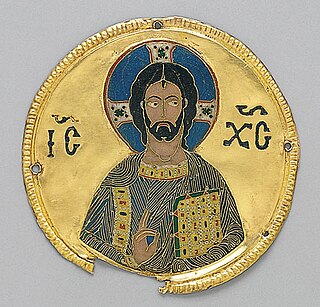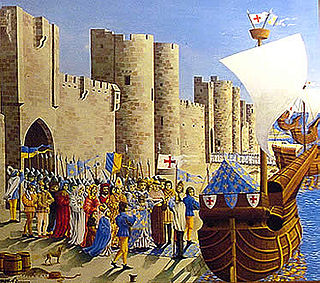The Northern Crusades or Baltic Crusades were Christian colonization and Christianization campaigns undertaken by Catholic Christian military orders and kingdoms, primarily against the pagan Baltic, Finnic and West Slavic peoples around the southern and eastern shores of the Baltic Sea, and to a lesser extent also against Orthodox Christian Slavs.
Crusader or Crusaders may refer to:

In heraldry, Saint George's Cross, the Cross of Saint George, is a red cross on a white background, which from the Late Middle Ages became associated with Saint George, the military saint, often depicted as a crusader.
Sigurd Magnusson, also known as Sigurd the Crusader, was King of Norway from 1103 to 1130. His rule, together with his half-brother Øystein, has been regarded by historians as a golden age for the medieval Kingdom of Norway. He is otherwise famous for leading the Norwegian Crusade (1107–1110), earning the eponym "the Crusader", and was the first European king to personally participate in a crusade.
Swedish–Novgorodian Wars were a series of conflicts in the 12th and 13th centuries between the Republic of Novgorod and medieval Sweden over control of the Gulf of Finland, an area vital to the Hanseatic League and part of the Varangian-Byzantine trade route. The Swedish attacks against Orthodox Russians had religious overtones, but before the 14th century there is no knowledge of official crusade bulls issued by the pope.

The Third Swedish Crusade to Finland was a Swedish military expedition against the pagan Karelians in 1293.

Vyborg Castle is a Swedish-built medieval fortress around which the town of Vyborg evolved. The castle became the stronghold of the Swedish realm in the Karelian region. Throughout the centuries, it was the first defence of the kingdom against Russians. Its military and strategic status in the late Middle Ages was second only to the fortified capital Stockholm. Currently it serves as the site of Vyborg Regional Museum.
Sweyn is a Scandinavian masculine given name which may refer to:

The Second Swedish Crusade was a possible 13th-century Swedish military expedition against the Tavastians, in present-day Finland, led by Birger Jarl. Many details of the Crusade are debated. After the crusade, Tavastia gradually started to fall under the rule of the Catholic Church and the Swedish kingdom.

The First Swedish Crusade was a mythical military expedition in the 1150s to Southwestern Finland by Swedish King Eric IX and English Bishop Henry of Uppsala.
Polish–Ottoman Wars can refer to one of the several conflicts between the Polish–Lithuanian Commonwealth and the Ottoman Empire:

The Livonian crusade refers to the various military Christianisation campaigns in medieval Livonia – in what is now Latvia and Estonia – during the Papal-sanctioned Northern Crusades in the 12–13th century. The Livonian crusade was conducted mostly by the Holy Roman Empire and the Kingdom of Denmark. It ended with the creation of Terra Mariana and the Danish duchy of Estonia. The lands on the eastern shores of the Baltic Sea were one of the last parts of Europe to be Christianised.
Polish–Teutonic War may refer to:

Christianity in the 12th century was marked by scholastic development and monastic reforms in the western church and a continuation of the Crusades, namely with the Second Crusade in the Holy Land.
Thing or The Thing may refer to:

Terra Mariana was the official name for Medieval Livonia or Old Livonia. It was formed in the aftermath of the Livonian Crusade, and its territories were composed of present-day Estonia and Latvia. It was established on 2 February 1207, as a principality of the Holy Roman Empire, but lost this status in 1215 when Pope Innocent III proclaimed it as directly subject to the Holy See.

Estonia under Swedish rule (1561–1710) signifies the period of time when large parts of the country, and after 1645, entire present-day Estonia, were under Swedish rule. In the wake of the breakup of the State of the Teutonic Order, the Baltic German local nobility in the areas of Harrien (Harjumaa) and Wierland (Virumaa), as well as the city of Reval (Tallinn) in June 1561 asked for and were granted protection by the Swedish king Eric XIV, leading to Swedish involvement in the Livonian War. At the conclusion of hostilities in 1583, Sweden was in control of the northern parts of modern Estonia and Dagö ; the Duchy of Estonia was created from this territory. Following renewed wars between Poland and Sweden, the southern parts of present-day Estonia were incorporated into Sweden by the Treaty of Altmark in 1629. Sweden also conquered the island of Ösel (Saaremaa) from Denmark, and were thus in control of all of present-day Estonia.

The history of Christian flags encompasses the establishment of Christian states, the Crusader era, and the 20th century ecumenical movement.
The Kalmare ledung was a crusade led by the Norwegian king Sigurd the Crusader performed in 1123 to Christianize the region of Småland. The crusade can be dated relatively accurately with information from Snorri Sturluson stating that the crusade must have taken place in the summer before the "great darkness". On 11 August 1124, a solar eclipse occurred, which means that the crusade most likely took place during the period June–August 1123.
This page is based on this
Wikipedia article Text is available under the
CC BY-SA 4.0 license; additional terms may apply.
Images, videos and audio are available under their respective licenses.








